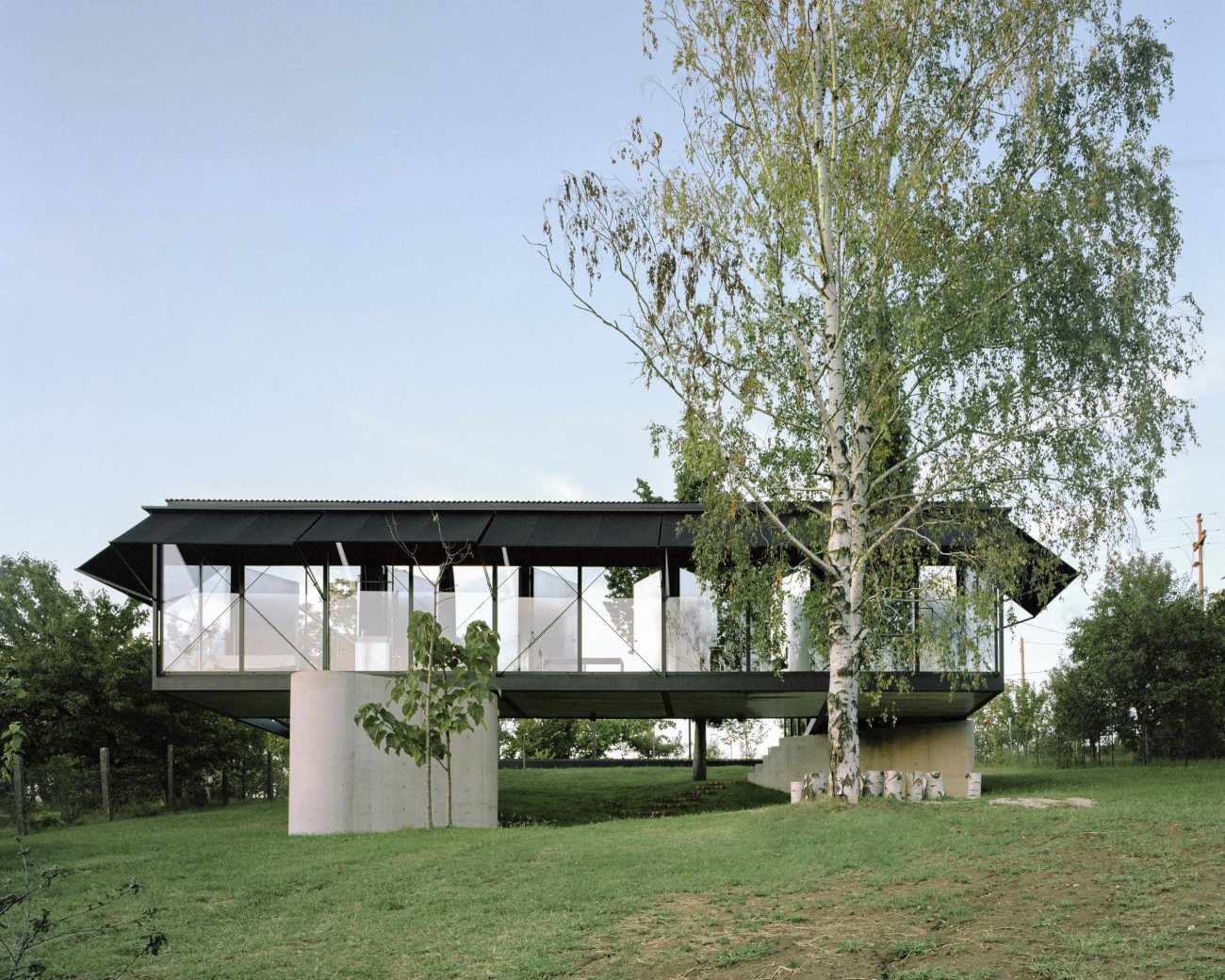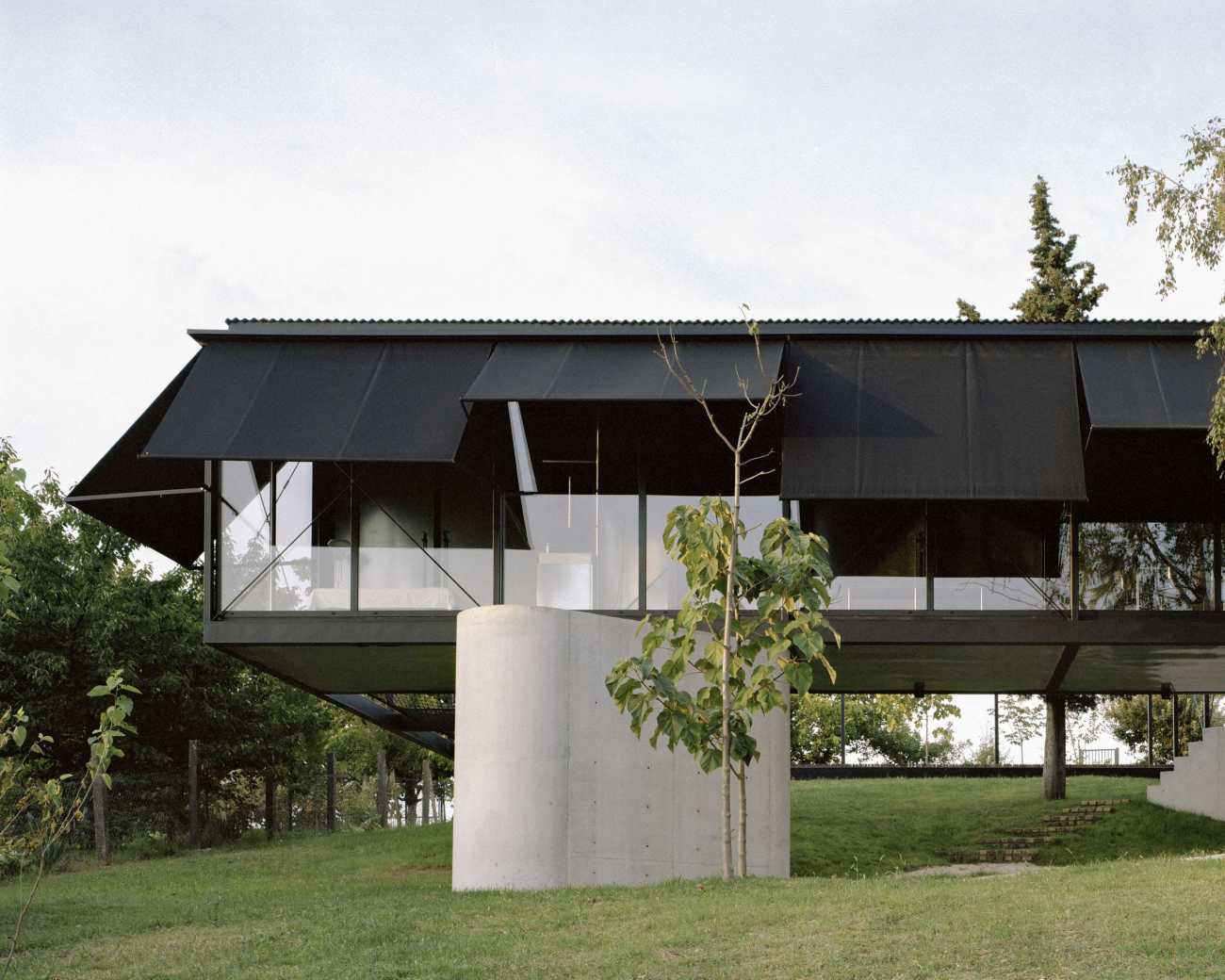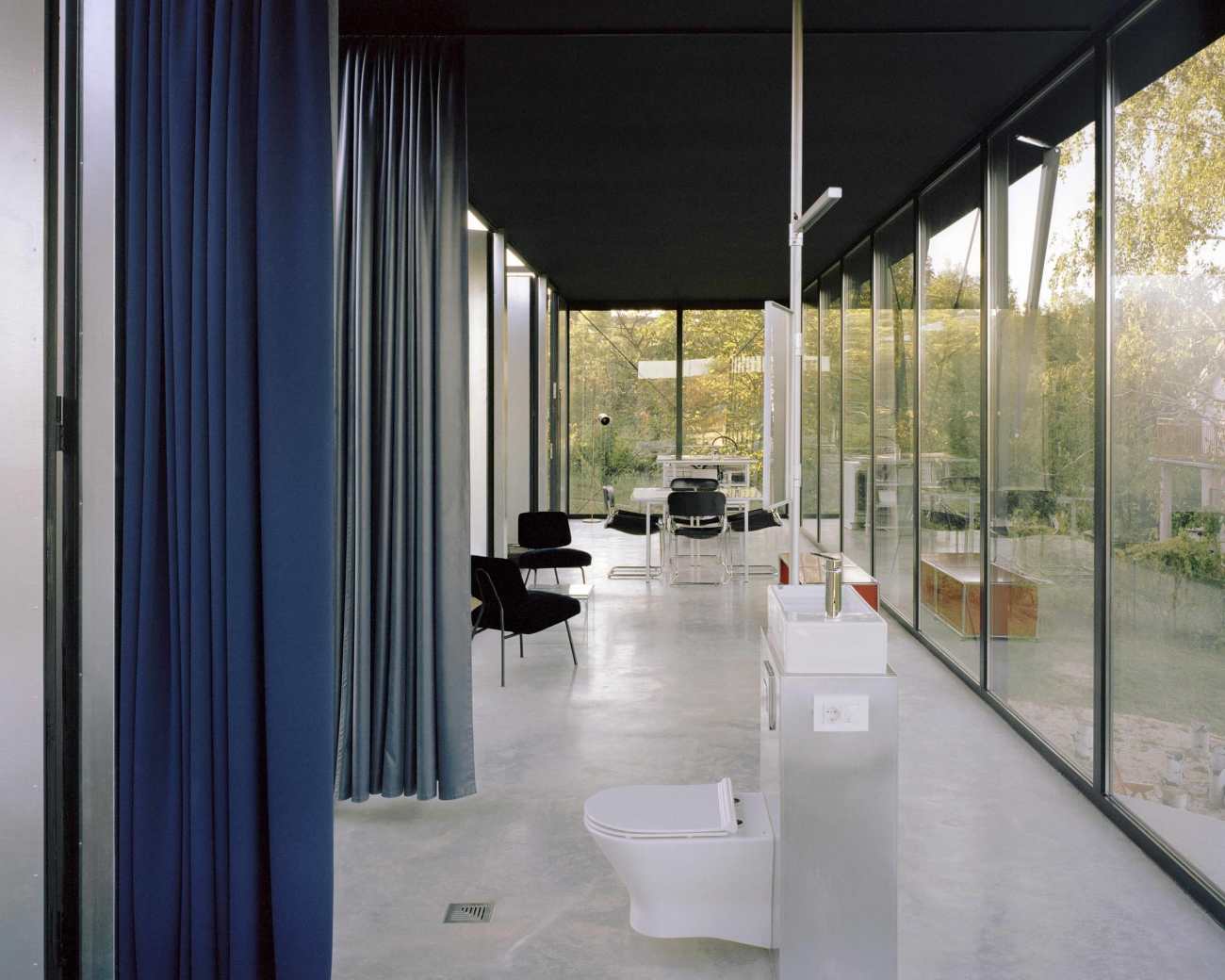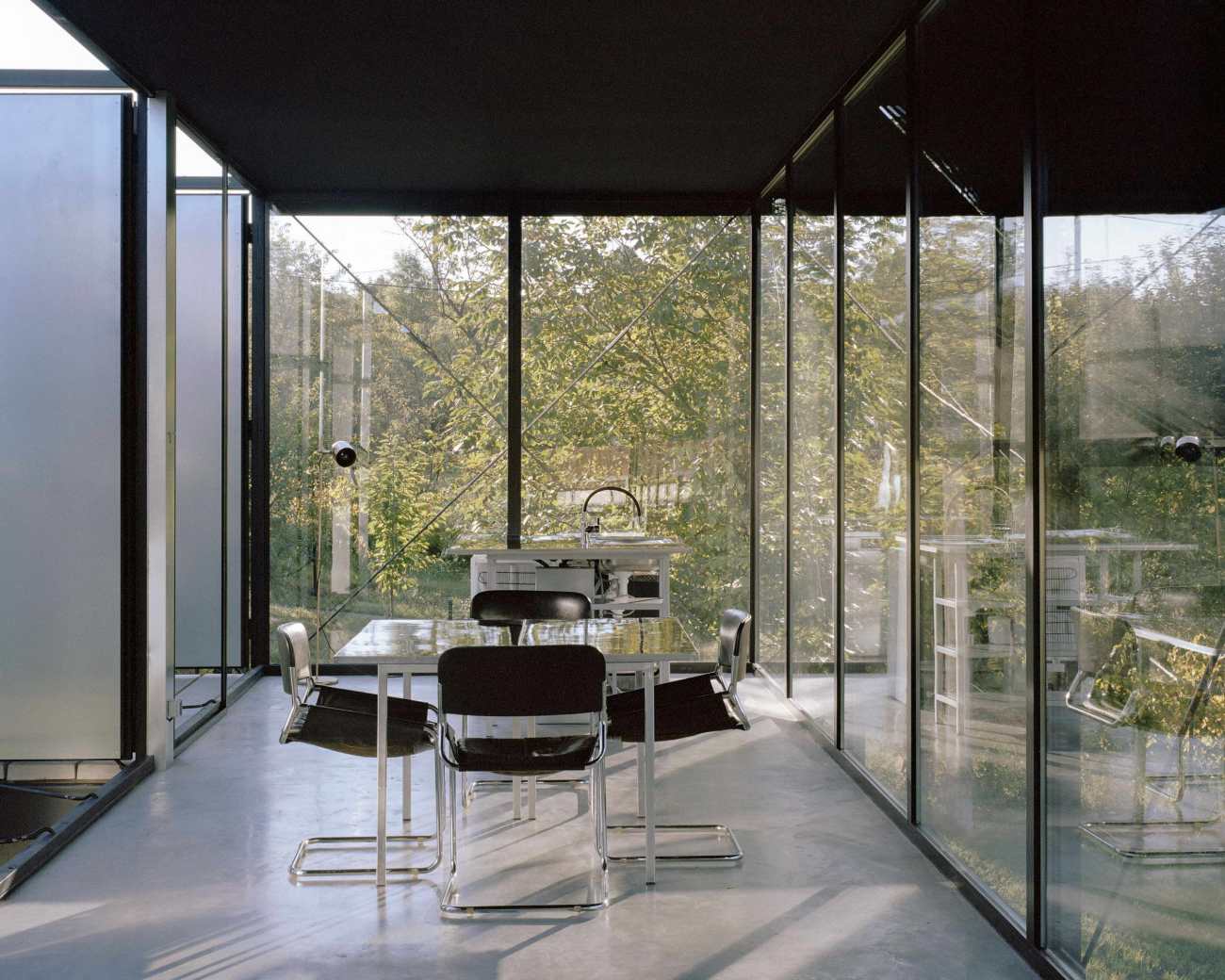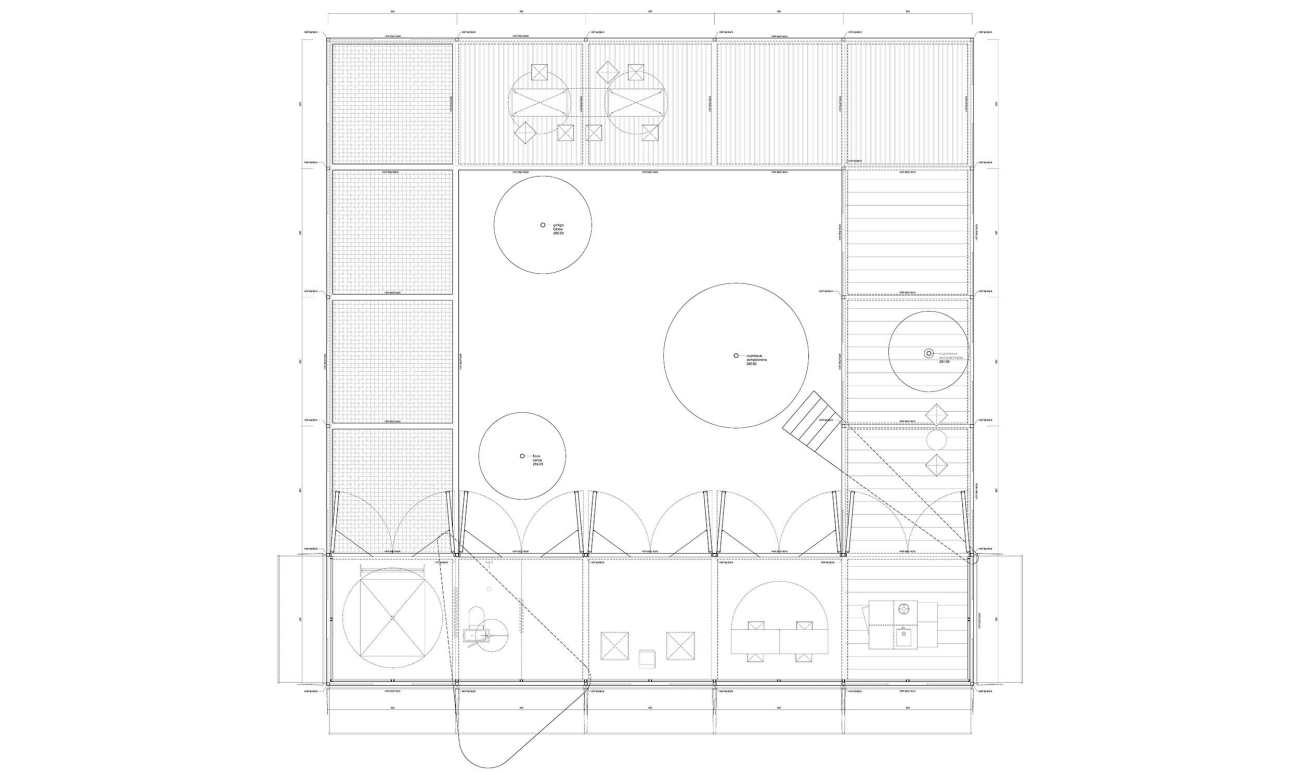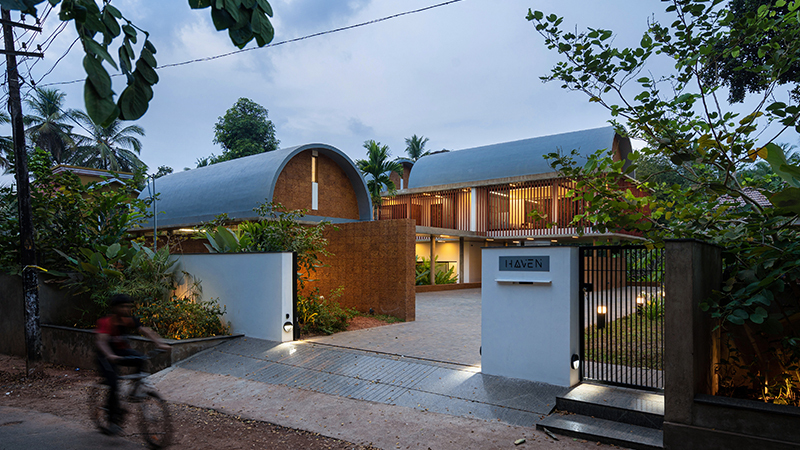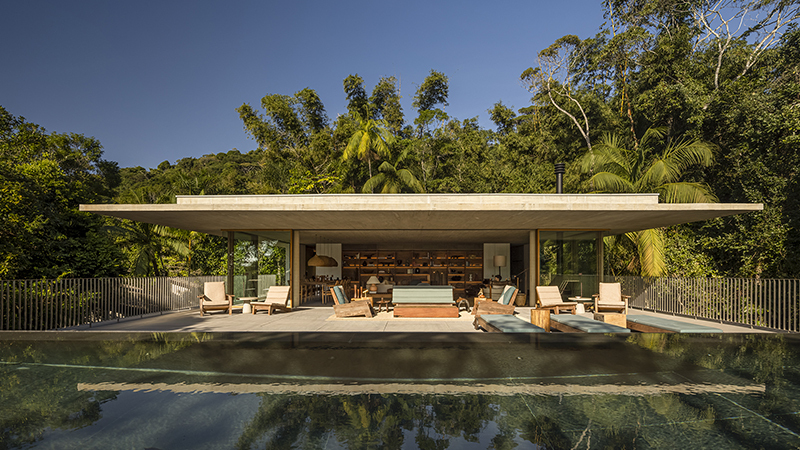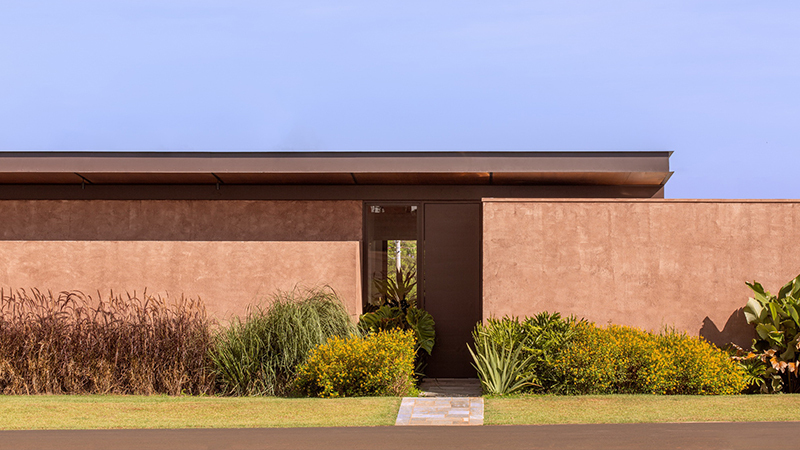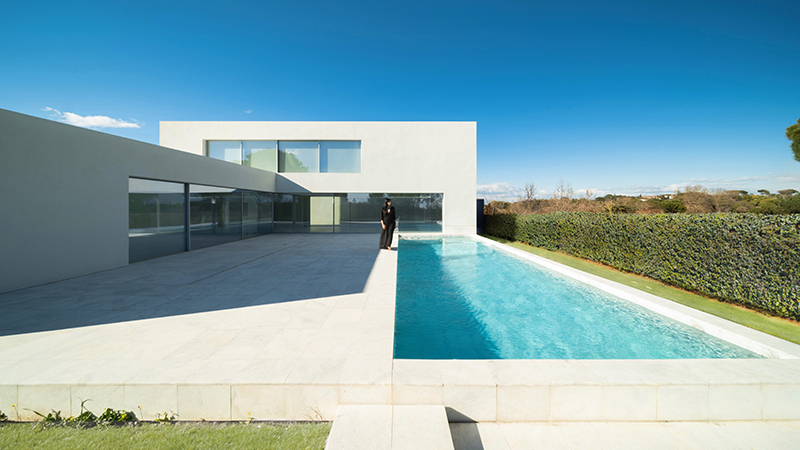Avala之家是位于塞尔维亚贝尔格莱德附近的Avala山上的一处田园风光中的住宅。这座房子是一个案例研究,研究如何通过设计努力将自给自足变成一种理想的生活形式。
The Avala House is a residence situated in a pastural landscape on Avala mountain near Belgrade in Serbia. The house is a case study on how design effort can turn sufficiency into a desirable form for living.
开放式框架
房子是一个单层空间,建在一个现有的向南倾斜的果园花园上。它由一个3.2米的网格框架组织,面积为16×16米的正方形,内部被切割出9.6×9.6米,露出下面的地形。周围的表面既形成了房屋的居住区,也划定了建筑的边界。框架利用80毫米的方形钢管型材焊接而成,并固定在地形上三个基础点的结构最小点上。这些点定义了地面上的到达区域,以及两个大型混凝土模板的定位--就像景观中的巨石--专用于外部花园楼梯和一个带有花园浴室的储藏空间。倾斜的地形在房子之间和房子下方延续,提供了一个阴凉的户外生活空间,并将景观、树木和自然地面覆盖引入建筑的中央空间。上面的主楼在现有的斜坡地形内设置了一个新的基准点,俯瞰周围的森林。开放式的结构拥抱着眼前的景观,同时设置了一个新的清晰的几何形状和强烈的建筑轮廓。
The open frame
The house is a single-story space built over an existing southward inclining orchard garden. It is organised by a 3.2 metre grid frame, measuring 16 by 16 metre square, with an interior cut out of 9.6 by 9.6 metres revealing the terrain below. The surrounding surface forms both the inhabited area of the house and delimits the building perimeter. The frame utilises 80 millimetre square steel tube profiles welded in place and fixed to the structural minimum of three foundation points on the terrain. These points define the arrival area on the ground plane, and the positioning of two large concrete forms –like boulders in the landscape – dedicated to both an outside garden staircase and a storage space with a garden bathroom. The sloping terrain continues between and underneath the house, offering a shaded outdoor living space, and introduces the landscape, trees and natural ground cover into the central space of the building. The main floor above sets a new datum within the topography of the existing slope overlooking the surrounding forest. The open structure embraces the immediate landscape while setting a new clear geometry and strong architectural outline.
平面布局是在外部网格上开发的,作为四个梯田的序列,在拐角处相互交错,为住宅提供一个新的地平线。每个露台都有不同的表面材料,为各种用途提供了可能性。钢架的边界不断受到材料(吊网、钢板、预制混凝土、开放式框架)的改变或通过其可移动元素的性能的挑战。这些都让房子经历了规模和气氛的全面转变。面向中央室内空间的不透明墙体由10扇大型旋转钢门组成,使生活区从50平方米的单一室内空间转移到四个室外露台156平方米的体积中。框架南面的大面积玻璃延伸了生活空间,使远处的山峦升起。定制的遮阳板封闭了这个广阔的空间,提供了一个独特的内部空间,由一系列从地面到天花板的全长窗帘将睡眠区与厨房、餐厅、起居室和浴室谨慎地分割开来。在开放的状态下,主生活在平面上是一体的,如果需要的话,可以将整个空间奉献给一个单一的项目。这栋房子颠覆了在自然中建造传统保护性庇护所的优先级,在建筑内允许各种场景与自然接触。
The plan is developed on the outer grid as a sequence of four terraces interlocking at corners to offer a new horizon for dwelling. Each terrace holds a different surface material, providing possibilities for a variety of use. The boundaries of the steel frame are constantly challenged by these alterations in material (a hanging net, sheet steel, pre-cast concrete, the open frame) or through the performance of its movable elements. These allow the house to undergo a total transformation of scale and atmosphere. The opaque wall facing the central interior space is made of 10 large pivoting steel doors, allowing the living area to shift from a singular indoor space of 50 square metres to embrace the 156 square metre volumes of the four outdoor terraces. The large stretch of glass on the southern facade of the frame extends the living space to the rise of the distant hills. The customised sun shading closes this expanse, giving a singular interior space, discretely partitioned by a series of floor to ceiling full-length curtains defining the sleeping area from the kitchen, dining, sitting, and bathroom. In its open state, the main living is one in plan, dedicating the entire space to a single program if desired. The house inverts the priority of building a traditional protected shelter in nature, by allowing various scenarios of exposure to nature within the building.
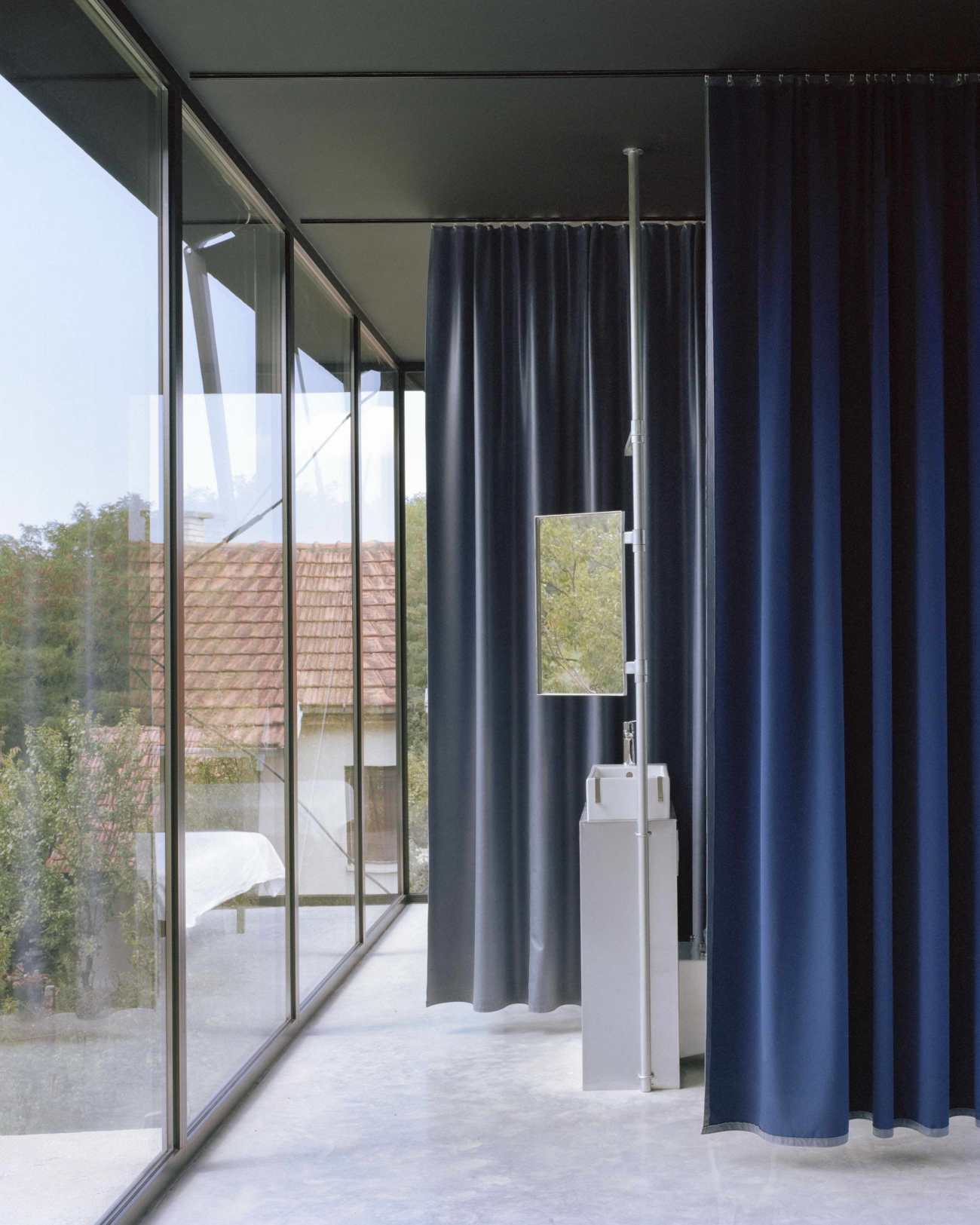 | 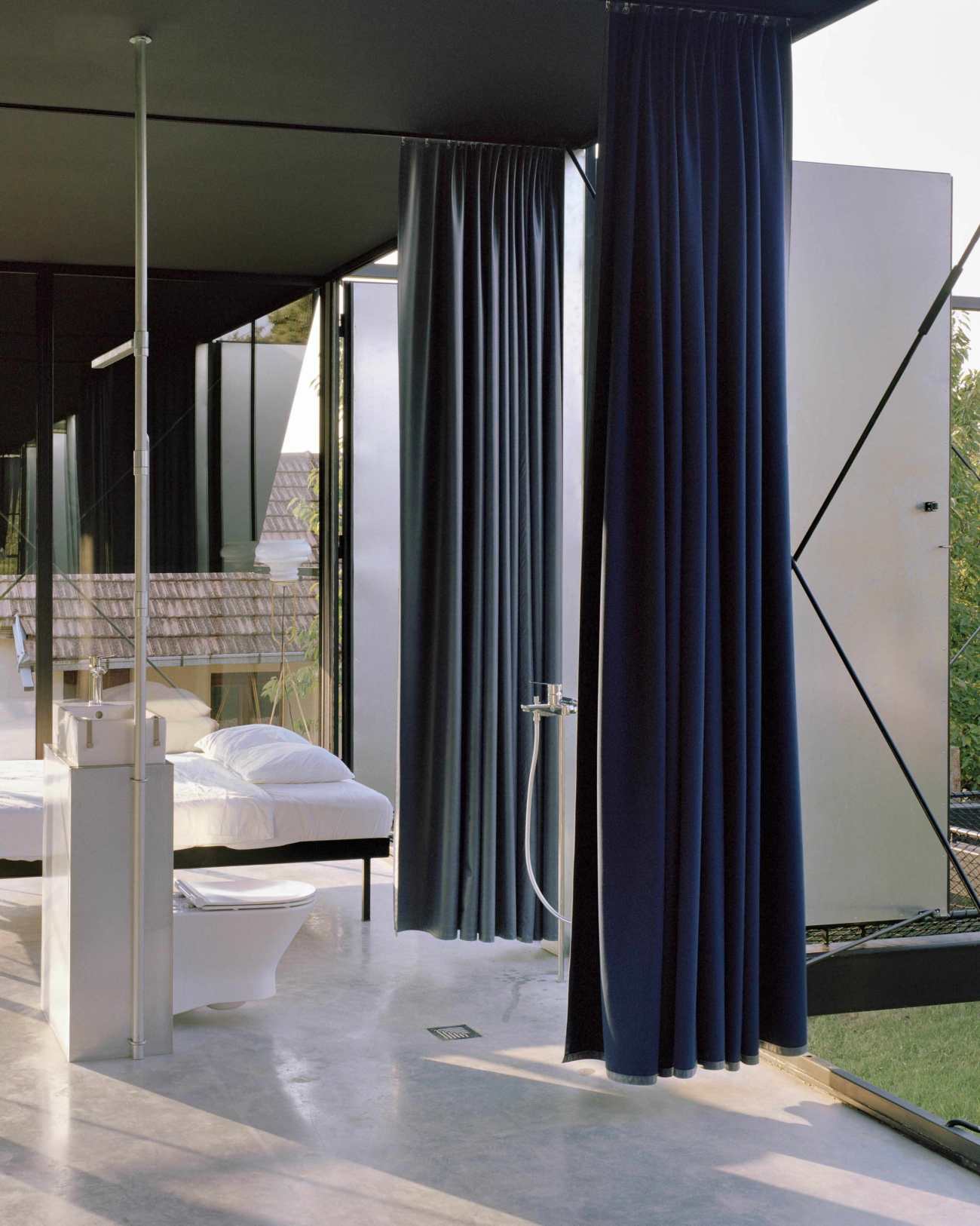 |
房子的每一个元素都强调结构和空间的表现,在特定的点上提供重量或轻盈,在其他点上提供扩张或收缩。这一点在主钢架的可见缝隙、与承重点的连接、外露的支撑和原材料的表面处理中得到了体现。所有的细节都会显现出来。有一种直接性,让所有人都能感受到房子的魅力。
Every element of the house emphasises the performance of structure and space, providing either weight or lightness at specific points, expanse or contraction at others. This is exemplified in the visible joints of the main steel frame, the connections to the bearing points, the exposed bracing and raw material finish. All details are revealed. There is a kind of directness that makes the house accessible to all.
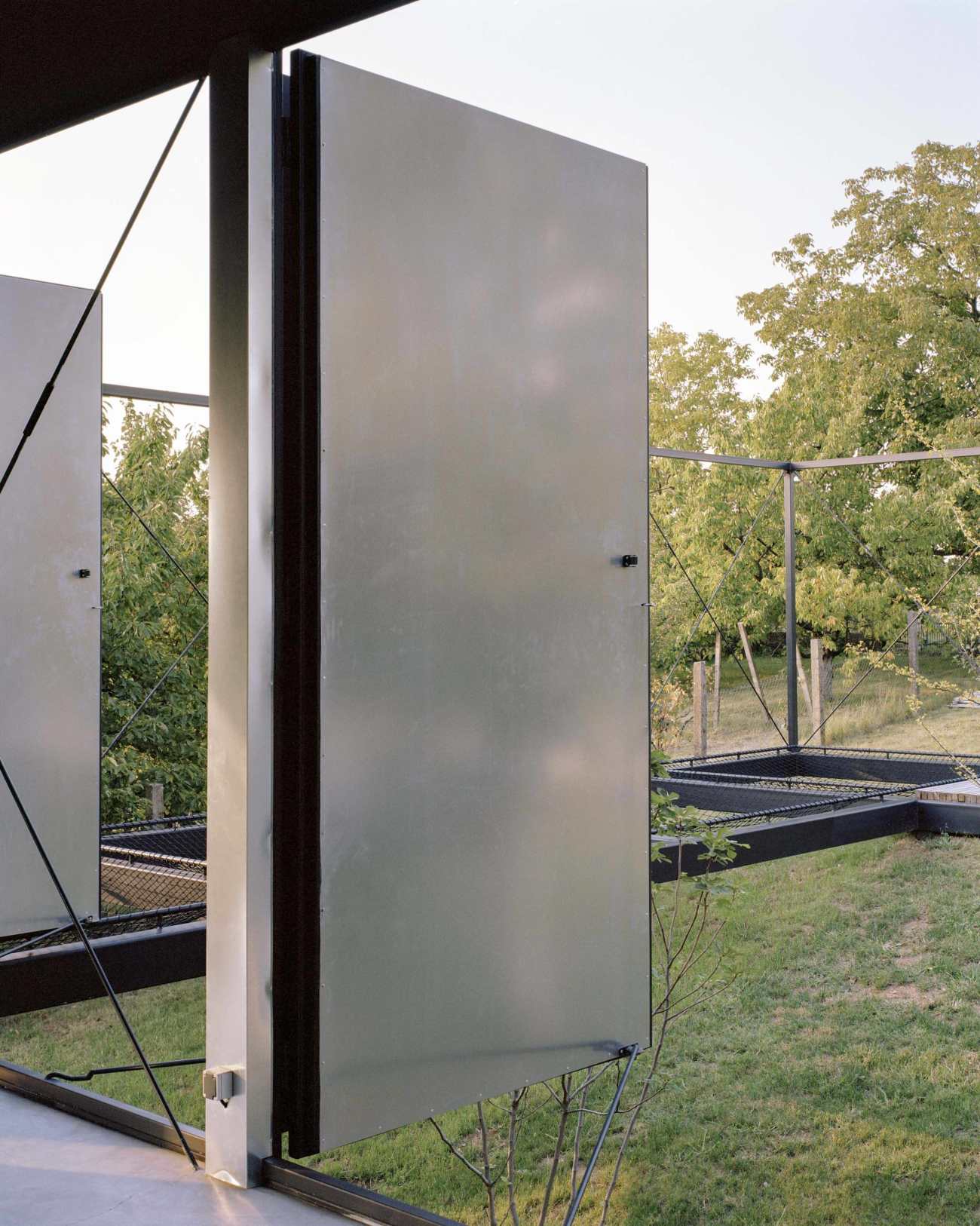 |  |
制作手段
业主是一位从事室内装修和家庭维修的当地工匠,他邀请TEN设计、开发和建造这栋房子。该项目的核心前提是让未来的业主参与到制作过程中,只指定当地现有的材料和建筑知识,设计决定耐用的结构和需要维修的表面。这挑战了建筑是一个完整的概念性产品的标准,通过客户交付到现场,而是打开了一个真正的对话过程,关于建设的过程,未来的使用和实际和必要的维护。
The means of making
The owner – a local craftsman working on interior refurbishments and domestic maintenance – invited TEN to design, develop and build the house. The central premise of the project was to include the future owner in the process of making by specifying only available local material and construction knowledge, with design decisions on durable structures and surfaces to be repaired. This challenged the norm of architecture being a complete conceptual product, delivered to the site via the client, but instead opened the process as a genuine conversation on the process of construction, the future use and practical and necessary maintenance.
 |  |
这次对话确定了材料资源、车间技能和邻近地区范围内的能力。它还带来了新颖的解决方案,比如用回收钢板就地浇筑裸露的混凝土地基。模板的精度由内部细木工决定,浇筑时使用的是与当地子公司和承包商共同开发的自密实混凝土混合物。这不仅为当地经济做出了贡献,而且通过在施工过程中的实验,为当地建筑技能提供了新的应用。暴露在外面,这揭示了劳动力和技能在建筑力量中的证明,而形式上的表达则展示了住宅生产中的人为因素。这扩展了源自南斯拉夫现代主义先驱的对话--通过在设计和建造中对进步技术和自决权的本地改造,这一运动有助于社会的转型。同样,Avala House以理想的当代住宅的形式,使用日常材料,由当地制造商的技能亲自形成,创造出具有区域意义的产品。
The conversation identified material resources, workshop skill and capacities within the range of the immediate region. It also brought about novel solutions like the in-situ casting of the exposed concrete foundations with recycled steel sheets. The accuracy of the formwork was determined by interior joiners, the casting with a self-compacting concrete mixture developed in dialogue with local subsidiaries and contractors. This not only contributed to the local economy but through experimentation in the procedure of construction, offered new applications for local construction skills. Left exposed, this reveals the proof of labour and skill in the forces driving construction, while the formal expression demonstrates the human factor in the production of dwelling. This extends the dialogue originating from the pioneers of Yugoslavian Modernism – a movement instrumental in the transformation of society through the local adaptation of progressive technologies and self-determination in design and construction. In the same way, the making of Avala House in the form of the ideal contemporary home uses everyday materials, formed personally by the skills of local makers to create a product of regional significance.
▽入口层平面图 Ground plan
▽平面图 Floor plan
▽剖面图 Section
▽剖面图 Section
▽立面图 Elevation
▽立面图 Elevation
Project name: Avala House
Architecture: TEN
Project Authors: Nemanja Zimonjić MSc ETH Arch, Ognjen Krašna, Jana Kulić, Dr. Miodrag Grbić
Structural design: TEN
Landscape: Ganz Landschaftsarchitekten
Gross floor area 156m²
Address: Kragujevacki put 82e, 11000 Belgrade
Client: Confidential
Execution & main contractor: Client
Construction cost: Undisclosed
Timeplan: 2017–19 Planning, 2019 Start on site, 2020 Completion on site
Photos:Maxime Delvaux, Brussels, Milos Martinovic, Belgrade, Relja Ivanic, Sombor
更新日期:2020-12-28 16:06:18
非常感谢 TEN 带来的精彩项目, 查阅更多Appreciations towards TEN for sharing wonderful work on hhlloo. Click to see more works!
